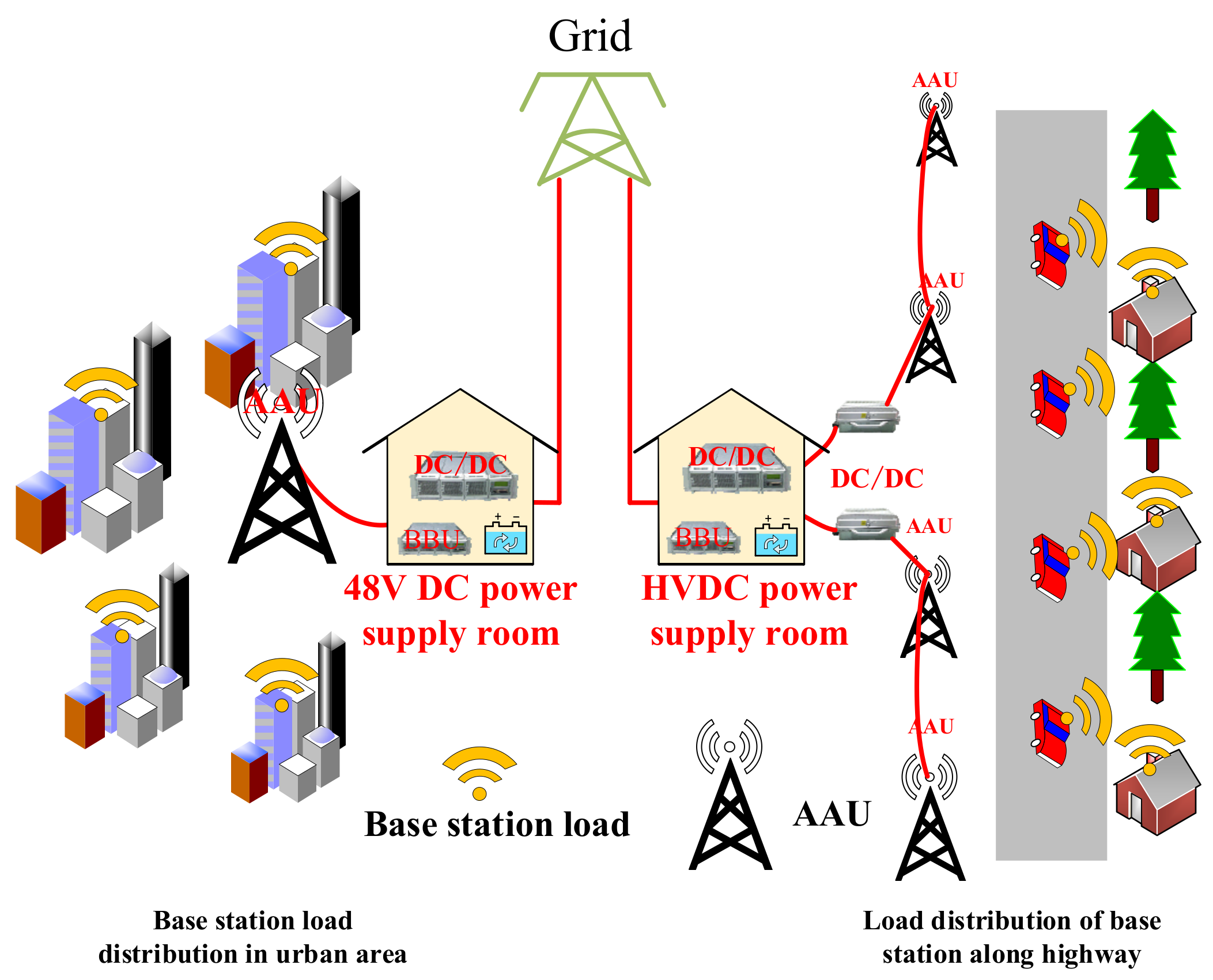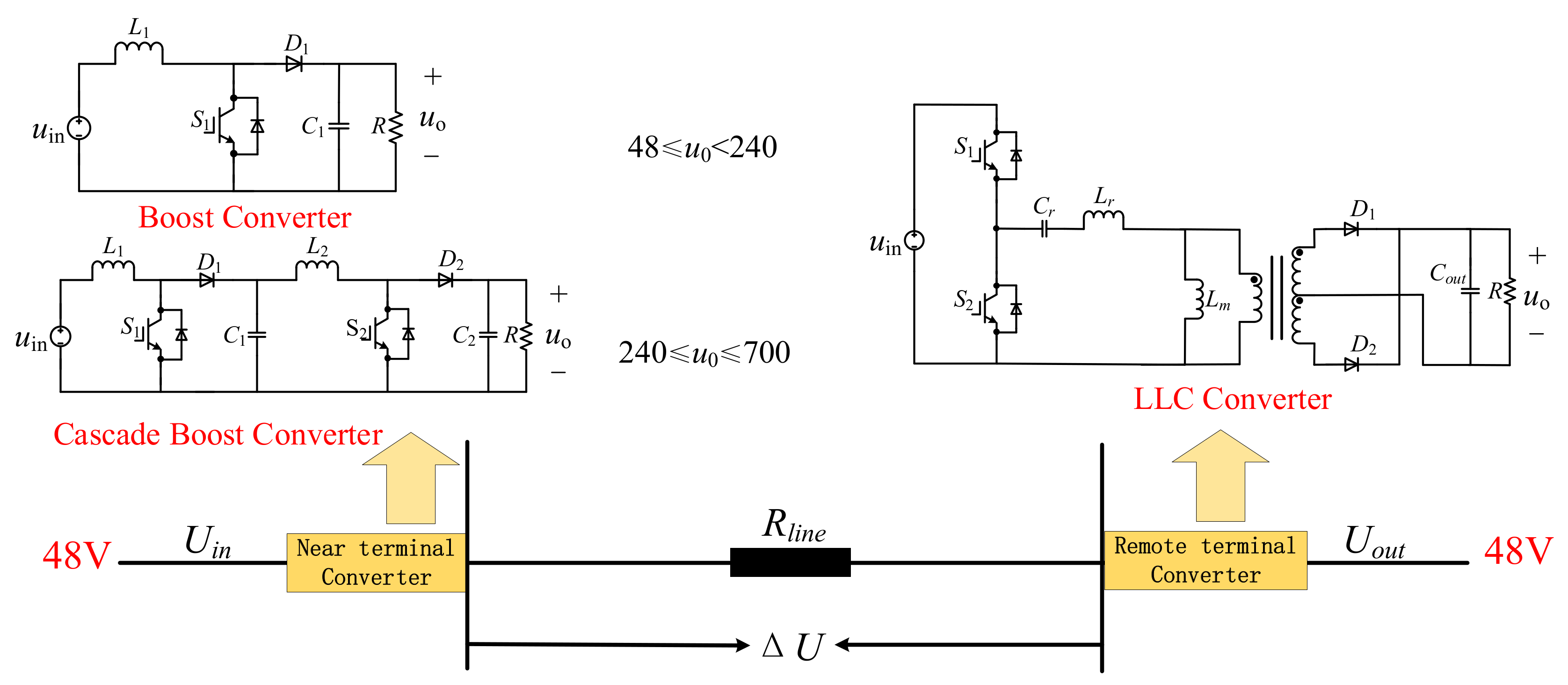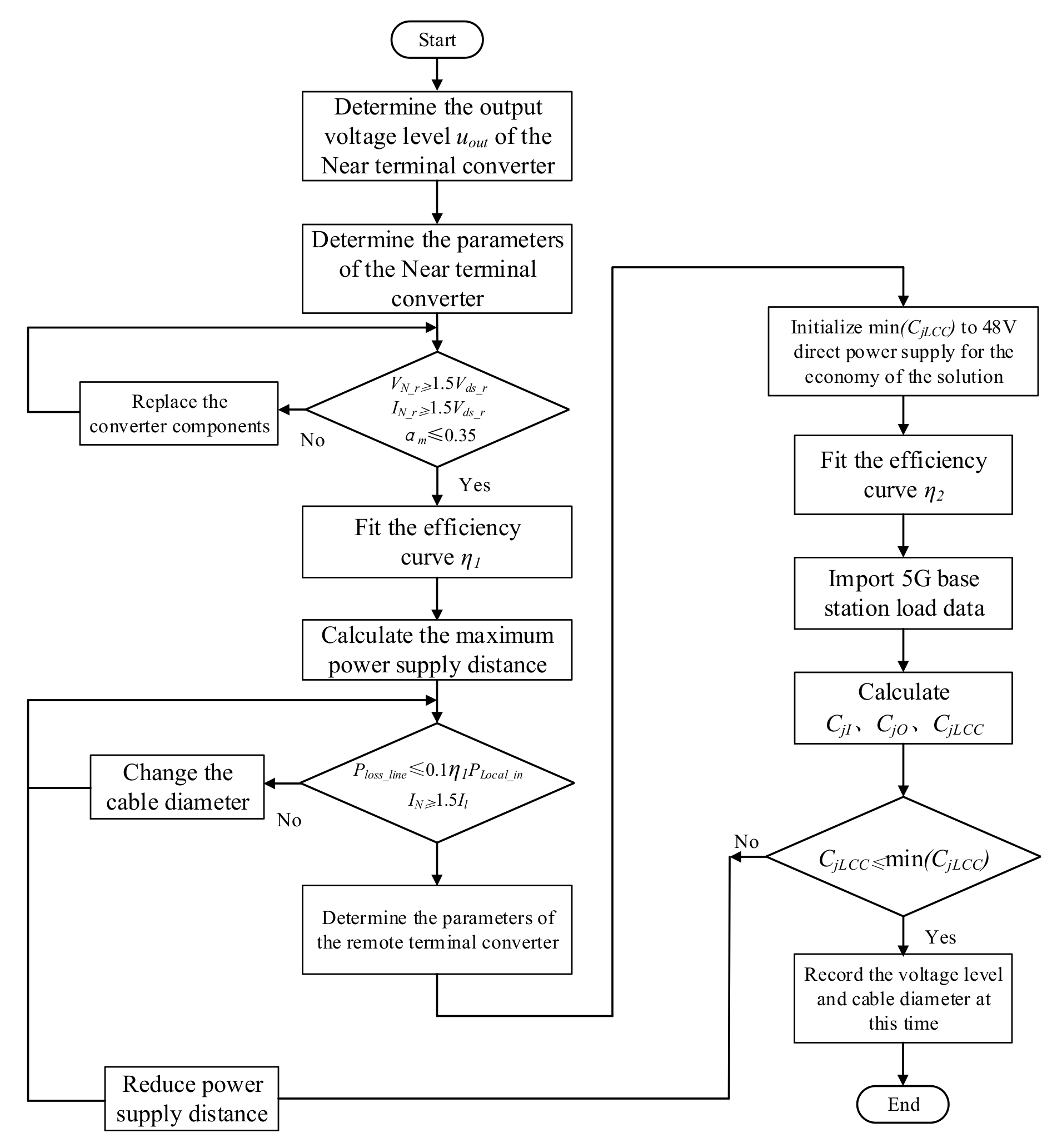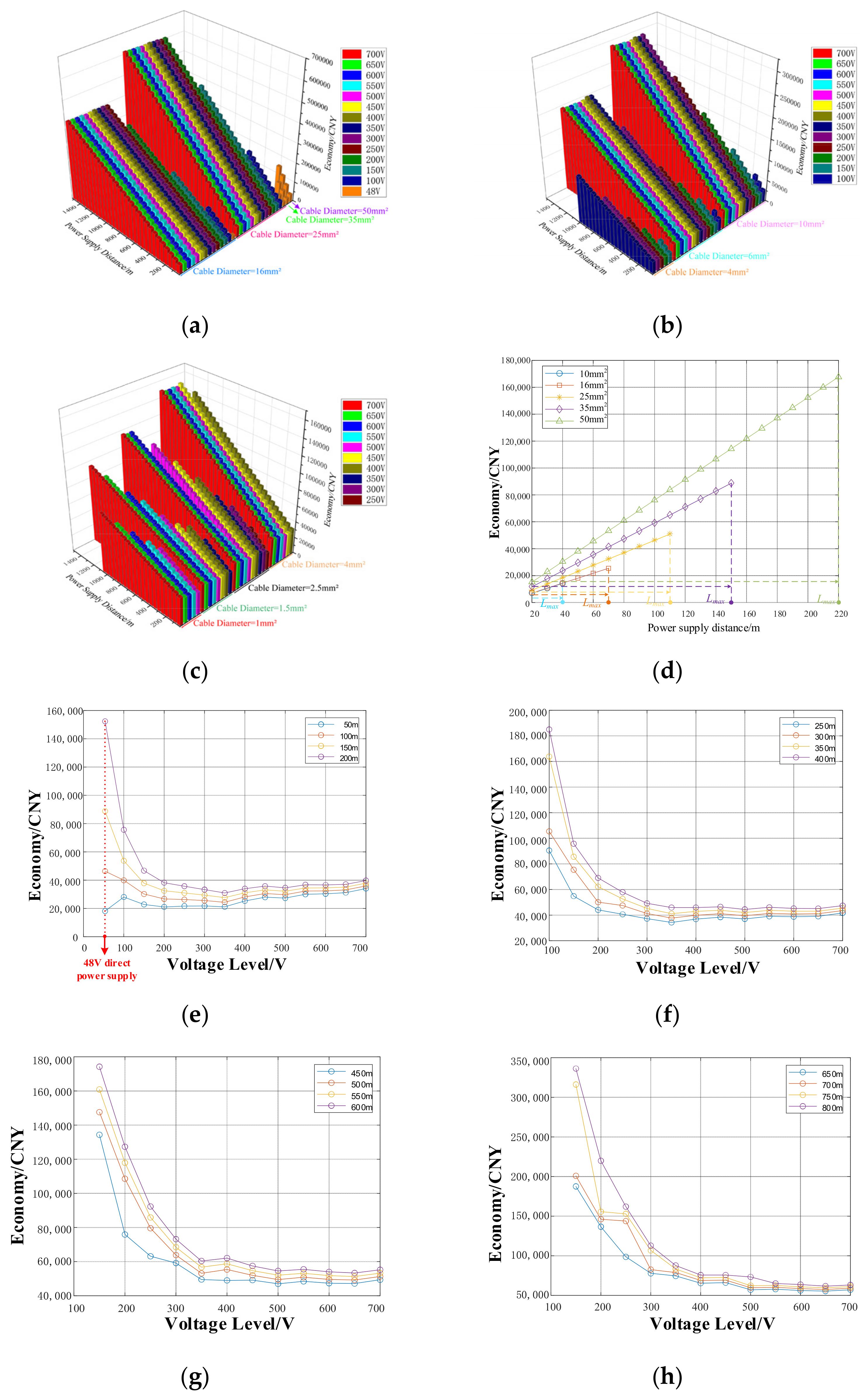A Voltage-Level Optimization Method for DC Remote Power Supply of 5G Base Station Based on Converter Behavior
Abstract
:1. Introduction
2. Model Building
2.1. Converter Loss Analysis
- The switching loss in Boost converter or Cascade Boost converter:
- 2.
- The diode loss in Boost converter or Cascade Boost converter:
- 3.
- The inductance loss in Boost converter or Cascade Boost converter:
- 4.
- The switching loss composition in LLC is shown in Formula (4):
- 5.
- The loss composition of the diode in the LLC converter is shown in Formula (5):
2.2. Refined Efficiency Model of the Converter
2.3. DC Remote Supply System Level Economic Model
- Initial investment cost.
- 2.
- Operating costs
3. Near Terminal Converter Voltage Level Optimization
3.1. Objective Function
3.2. Constraints
- Constraints on line power balance
- 2.
- Power balance constraints of 5G base station
- 3.
- Constraints on wire diameter selection
- 4.
- Window coefficient constraint
- 5.
- components selection constraints
- 6.
- Line loss constraints
3.3. Flowchart Description
4. Simulations
4.1. Converter Efficiency Curve Fitting
4.2. Analysis of Optimization Results
4.3. Comparative Analysis
5. Conclusions
- The output efficiency of the converter is constantly changing in the actual operation, and if it is assumed to be constant in the design of the scheme, the final optimization result will be seriously affected.
- A 48 V direct power supply is recommended when the power supply distance is less than 100 m, and an HVDC remote power supply should be considered when the distance is greater than 100 m.
- In the central city (240–300 m), the new city (300–350 m), the township (400–500 m), and other remote areas (1000–1200 m), the optimal voltage level is mainly concentrated in 350 V, 500 V, 650 V, and 700 V.
- Enhancing Energy Efficiency: Research methods to improve the energy utilization efficiency of high-voltage direct current power supply systems, reducing energy losses, and optimizing energy conversion and transmission efficiency.
- Improve the System reliability and stability: Based on the converter behavior mentioned in this paper, the method of improving system reliability and reducing equipment failure rate is studied, and advanced monitoring technology and predictive maintenance are used to ensure the stable operation of the system.
- Integration of New Technologies: Exploring the integration of emerging technologies like smart grids, energy storage techniques, etc., to enhance the overall effectiveness of power supply systems and seek more sustainable and intelligent solutions.
Author Contributions
Funding
Data Availability Statement
Conflicts of Interest
References
- Agiwal, M.; Kwon, H.; Park, S.; Jin, H. A survey on 4G–5G dual connectivity: Road to 5G implementation. IEEE Access 2021, 9, 16193–16210. [Google Scholar] [CrossRef]
- Ahmed Osman, R.; Zaki, A.I. Energy-efficient and reliable internet of things for 5G: A framework for interference control. Electronics 2020, 9, 2165. [Google Scholar] [CrossRef]
- Qasim, M.; Haroon, M.S.; Imran, M.; Muhammad, F.; Kim, S. 5G cellular networks: Coverage analysis in the presence of inter-cell interference and intentional jammers. Electronics 2020, 9, 1538. [Google Scholar] [CrossRef]
- Chang, K.C.; Chu, K.C.; Wang, H.C.; Lin, Y.C.; Pan, J.S. Energy saving technology of 5G base station based on internet of things collaborative control. IEEE Access 2020, 8, 32935–32946. [Google Scholar] [CrossRef]
- Andrews, J.G.; Buzzi, S.; Choi, W.; Hanly, S.V.; Lozano, A.; Soong, A.C.; Zhang, J.C. What will 5G be? IEEE J. Sel. Areas Commun. 2014, 32, 1065–1082. [Google Scholar] [CrossRef]
- Tao, J.; Umair, M.; Ali, M.; Zhou, J. The impact of Internet of Things supported by emerging 5G in power systems: A review. CSEE J. Power Energy Syst. 2019, 6, 344–352. [Google Scholar]
- Parvez, I.; Rahmati, A.; Guvenc, I.; Sarwat, A.I.; Dai, H. A survey on low latency towards 5G: RAN, core network and caching solutions. IEEE Commun. Surv. Tutor. 2018, 20, 3098–3130. [Google Scholar] [CrossRef]
- Ni, Y.; Liang, J.; Shi, X.; Ban, D. Research on key technology in 5G mobile communication network. In Proceedings of the 2019 International Conference on Intelligent Transportation, Big Data & Smart City, Changsha, China, 12–13 January 2019; pp. 199–201. [Google Scholar]
- Li, J.; Feng, Y.; Hu, Y. Load Forecasting of 5G Base Station in Urban Distribution Network. In Proceedings of the 2021 IEEE 5th Conference on Energy Internet and Energy System Integration, Taiyuan, China, 22–24 October 2021; pp. 1308–1313. [Google Scholar]
- Yaacoub, E.; Alouini, M.S. A key 6G challenge and opportunity—Connecting the base of the pyramid: A survey on rural connectivity. Proc. IEEE 2020, 108, 533–582. [Google Scholar] [CrossRef]
- Wang, Z.; Huang, J. Research of power supply and monitoring mode for small sites under 5G network architecture. In Proceedings of the 2018 IEEE International Telecommunications Energy Conference, Turino, Italy, 7–11 October 2018; pp. 1–4. [Google Scholar]
- Ci, S.; He, H.; Kang, C.; Yang, Y. Building digital battery system via energy digitization for sustainable 5G power feeding. IEEE Wirel. Commun. 2020, 27, 148–154. [Google Scholar] [CrossRef]
- Liu, J.; Wang, S.; Yang, Q.; Li, H.; Deng, F.; Zhao, W. Feasibility study of power demand response for 5G base station. In Proceedings of the 2021 IEEE International Conference on Power Electronics, Computer Applications, Shenyang, China, 22–24 January 2021; pp. 1038–1041. [Google Scholar]
- Li, Z.; Ma, T.; Wang, L.; Yang, J. Design and Application of Highway DC Power Supply System. In Proceedings of the 2022 2nd International Conference on Electronic Information Technology and Smart Agriculture, Huaihua, China, 9–11 December 2022; pp. 1–6. [Google Scholar]
- Agiwal, M.; Roy, A.; Saxena, N. Next generation 5G wireless networks: A comprehensive survey. IEEE Commun. Surv. Tutor. 2016, 18, 1617–1655. [Google Scholar] [CrossRef]
- Watson, N.R.; Watson, J.D. An overview of HVDC technology. Energies 2020, 13, 4342. [Google Scholar] [CrossRef]
- Zhang, H.; Guo, H.; Xie, W. Research on performance of power saving technology for 5G base station. In Proceedings of the 2021 International Wireless Communications and Mobile Computing, Harbin, China, 28 June–2 July 2021; pp. 194–198. [Google Scholar]
- Foucault, O.; Marquet, D.; Le Masson, S. 400VDC Remote Powering as an alternative for power needs in new fixed and radio access networks. In Proceedings of the 2016 IEEE International Telecommunications Energy Conference, Austin, TX, USA, 23–27 October 2016; pp. 1–9. [Google Scholar]
- Qi, S.; Gong, X.; Li, S. Study on power feeding system for 5G network. In Proceedings of the 2018 IEEE International Telecommunications Energy Conference, Turino, Italy, 7–11 October 2018; pp. 1–4. [Google Scholar]
- Ge, X.; Tu, S.; Mao, G.; Wang, C.-X.; Han, T. 5G ultra-dense cellular networks. IEEE Wirel. Commun. 2016, 23, 72–79. [Google Scholar] [CrossRef]
- Buzzi, S.; D’Andrea, C.; Zappone, A.; D’Elia, C. User-centric 5G cellular networks: Resource allocation and comparison with the cell-free massive MIMO approach. IEEE Trans. Wirel. Commun. 2019, 19, 1250–1264. [Google Scholar] [CrossRef]
- Qi, S.; Sun, W.; Wu, Y. Comparative analysis on different architectures of power supply system for data center and telecom center. In Proceedings of the 2017 IEEE International Telecommunications Energy Conference, Broadbeach, Australia, 22–26 October 2017; pp. 26–29. [Google Scholar]
- Liu, M.; Hu, X.; Liu, L.; Wang, Z. Power supply solutions and trends analysis for Small Cell mobile communication base station. In Proceedings of the 2018 IEEE International Telecommunications Energy Conference, Turino, Italy, 7–11 October 2018; pp. 1–6. [Google Scholar]
- Borders, K.; Clark, G.; Hariharan, S.; Wilson, T. Best practices guide for remote line power. In Proceedings of the 2017 IEEE International Telecommunications Energy Conference, Broadbeach, Australia, 22–26 October 2017; pp. 177–182. [Google Scholar]
- Hariharan, S.; Borders, K.; McCrea, B. A case study of a remote line powered small cell network. In Proceedings of the 2018 IEEE International Telecommunications Energy Conference, Turino, Italy, 7–11 October 2018; pp. 1–4. [Google Scholar]
- Huang, H.; Xiao, Y.H.; Yu, S.; Mao, X.; Li, B.; Liu, L.; Du, H. research on lightning protection and grounding safety evaluation of base station shared power tower. In Proceedings of the 2022 IEEE 5th International Electrical and Energy Conference, Nanjing, China, 27–29 May 2022; pp. 843–848. [Google Scholar]
- Hariharan, S.; Loeffelholz, T.; Lumanog, G. Powering outdoor small cells over twisted pair or coax cables. In Proceedings of the 2018 IEEE International Telecommunications Energy Conference, Turino, Italy, 7–11 October 2018; pp. 1–6. [Google Scholar]
- Zhao, L.; Yao, G.; Zhou, L.; Liu, S. A Review of 5G Technology Application in Digital Smart Grid. In Proceedings of the 2023 8th International Conference on Intelligent Computing and Signal Processing, Xi’an, China, 21–23 April 2023; pp. 1695–1701. [Google Scholar]
- Ma, Z.; Li, Y.; Sun, Y.; Sun, K. Low Voltage Direct Current Supply and Utilization System: Definition, Key Technologies and Development. CSEE J. Power Energy Syst. 2022, 9, 331–350. [Google Scholar]
- Rezaie, M.; Abbasi, V. Effective combination of quadratic boost converter with voltage multiplier cell to increase voltage gain. IET Power Electron. 2020, 13, 2322–2333. [Google Scholar] [CrossRef]
- Zhu, B.; Yang, Y.; Wang, K.; Liu, J.; Vilathgamuwa, D.M. High Transformer Utilization Ratio and High Voltage Conversion Gain Flyback Converter for Photovoltaic Application. IEEE Trans. Ind. Appl. 2023, 1–13. [Google Scholar] [CrossRef]
- Zhu, B.; Liu, Y.; Zhi, S.; Wang, K.; Liu, J. A Family of Bipolar High Step-Up Zeta–Buck–Boost Converter Based on “Coat Circuit”. IEEE Trans. Power Electron. 2022, 38, 3328–3339. [Google Scholar] [CrossRef]
- Zhu, B.; Liu, J.; Liu, Y.; Wang, K. Fault-tolerance wide voltage conversion gain DC/DC converter for more electric aircraft. Chin. J. Aeronaut. 2023, 36, 420–429. [Google Scholar] [CrossRef]
- Li, M.; Ouyang, Z.; Andersen, M.A.E. High-frequency LLC resonant converter with magnetic shunt integrated planar transformer. IEEE Trans. Power Electron. 2018, 34, 2405–2415. [Google Scholar] [CrossRef]
- Zhu, B.; Ren, L.; Wu, X.; Song, K. ZVT high step-up DC/DC converter with a novel passive snubber cell. IET Power Electron. 2017, 10, 599–605. [Google Scholar] [CrossRef]
- Gabr, A.Z.; Helal, A.A.; Abbasy, N.H. Multiobjective optimization of photo voltaic battery system sizing for grid-connected residential prosumers under time-of-use tariff structures. IEEE Access 2021, 9, 74977–74988. [Google Scholar] [CrossRef]
- Shafiei, N.; Saket, M.A.; Ordonez, M. Time domain analysis of LLC resonant converters in the boost mode for battery charger applications. In Proceedings of the 2017 IEEE Energy Conversion Congress and Exposition, Cincinnati, OH, USA, 1–5 October 2017; pp. 4157–4162. [Google Scholar]










| Parameters | Value |
|---|---|
| Power purchase price/CNY | 0.667 |
| 1 mm2 cable/CNY/m | 2.52 |
| 1.5 mm2 cable/CNY/m | 3.26 |
| 2.5 mm2 cable/CNY/m | 5.06 |
| 4 mm2 cable/CNY/m | 7.49 |
| 6 mm2 cable/CNY/m | 10.73 |
| 10 mm2 cable/CNY/m | 17.06 |
| 16 mm2 cable/CNY/m | 24.59 |
| 25 mm2 cable/CNY/m | 38.92 |
| 35 mm2 cable/CNY/m | 53.87 |
| 50 mm2 cable/CNY/m | 72.44 |
| Voltage Level/V | Power Supply Distance/m | Cable Diameter/mm2 | Economy/CNY |
|---|---|---|---|
| 48 | 50 | 10 | 17,882 |
| 350 | 100 | 1.5 | 24,367 |
| 350 | 150 | 1.5 | 27,611 |
| 350 | 200 | 1.5 | 30,906 |
| 350 | 250 | 1.5 | 34,254 |
| 350 | 300 | 1.5 | 37,657 |
| 350 | 350 | 1.5 | 41,117 |
| 500 | 400 | 1.5 | 44,492 |
| 500 | 450 | 1.5 | 46,995 |
| 650 | 500 | 1 | 49,222 |
| 650 | 550 | 1 | 51,279 |
| 650 | 600 | 1 | 53,347 |
| 650 | 650 | 1 | 55,427 |
| 650 | 700 | 1 | 57,518 |
| 650 | 750 | 1 | 59,621 |
| 650 | 800 | 1 | 61,736 |
| 650 | 850 | 1 | 63,863 |
| 650 | 900 | 1 | 66,002 |
| 650 | 1100 | 1.5 | 76,299 |
| 650 | 1150 | 1.5 | 78,495 |
| 650 | 1200 | 1.5 | 80,696 |
| 700 | 950 | 1 | 69,210 |
| 700 | 1000 | 1 | 71,244 |
| 700 | 1050 | 1 | 73,288 |
Disclaimer/Publisher’s Note: The statements, opinions and data contained in all publications are solely those of the individual author(s) and contributor(s) and not of MDPI and/or the editor(s). MDPI and/or the editor(s) disclaim responsibility for any injury to people or property resulting from any ideas, methods, instructions or products referred to in the content. |
© 2023 by the authors. Licensee MDPI, Basel, Switzerland. This article is an open access article distributed under the terms and conditions of the Creative Commons Attribution (CC BY) license (https://creativecommons.org/licenses/by/4.0/).
Share and Cite
Zhu, B.; Guo, H.; Wang, Y.; Wang, K. A Voltage-Level Optimization Method for DC Remote Power Supply of 5G Base Station Based on Converter Behavior. Electronics 2024, 13, 51. https://doi.org/10.3390/electronics13010051
Zhu B, Guo H, Wang Y, Wang K. A Voltage-Level Optimization Method for DC Remote Power Supply of 5G Base Station Based on Converter Behavior. Electronics. 2024; 13(1):51. https://doi.org/10.3390/electronics13010051
Chicago/Turabian StyleZhu, Binxin, Hao Guo, Yizhang Wang, and Kaihong Wang. 2024. "A Voltage-Level Optimization Method for DC Remote Power Supply of 5G Base Station Based on Converter Behavior" Electronics 13, no. 1: 51. https://doi.org/10.3390/electronics13010051





